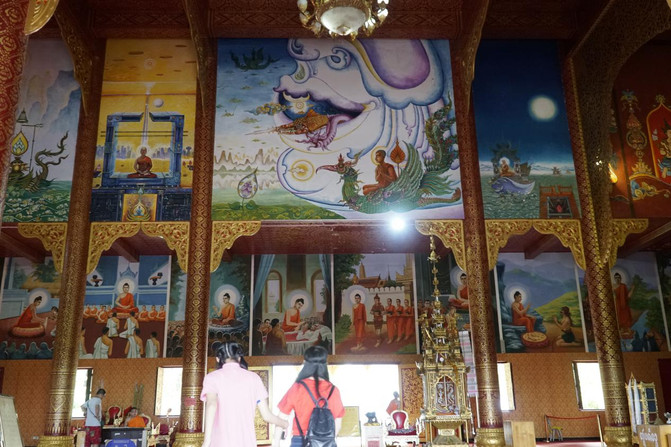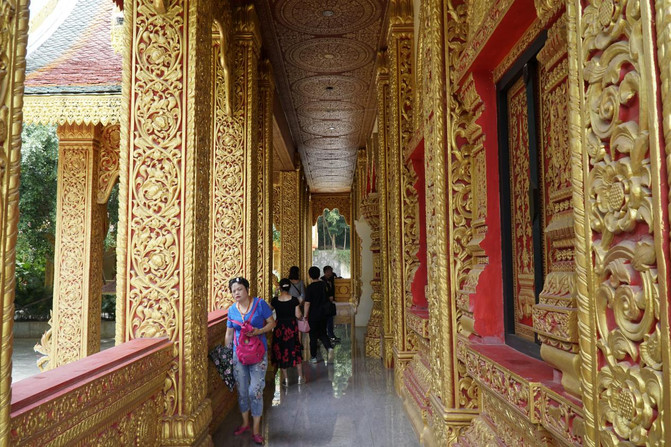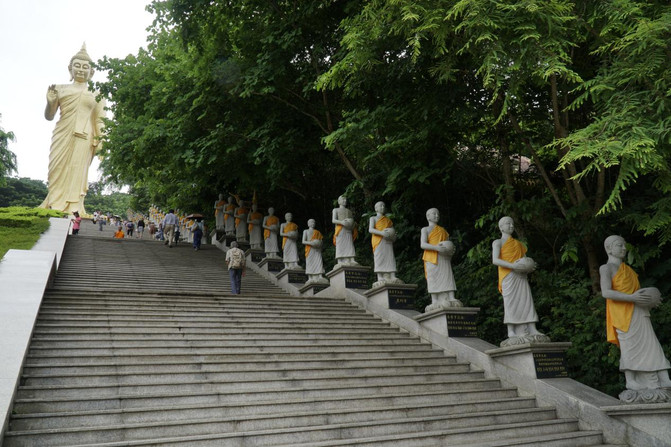Visit Mengle Dafo Temple and experience different southern Buddhist culture
China is so big, I want to visit it. Take you to a place you have been or have not been.
Visit Mengle Dafo Temple and experience different southern Buddhist culture

Buddhism originated in ancient India. The Buddhist form during Buddha's lifetime until a hundred years after Nirvana was called "primitive Buddhism", and then there was a division between the sects. In the third century BC, the ancient Indian Buddhist monks introduced Buddhism to Sri Lanka, and they still retain the style of primitive Buddhism to the greatest extent on important issues such as reciting classics, fundamental teachings, precepts and practices, mantle and costumes, monk community system, and study methods. It is called Theravada Buddhism. Because Sri Lanka is south of India, also known as Southern Buddhism, it is prevalent in Sri Lanka in South Asia, Myanmar, Thailand, Cambodia and Laos in Southeast Asia, and my country's Yunnan Province. It was a faction of Bu Buddhism after the primitive Buddhist period.

In about the mid-7th century, southern Buddhism was introduced from Myanmar to the Dai areas of Yunnan in my country. Affected by culture, the Dai people have believed in Theravada Buddhism for generations."There are Buddhist temples in every village and monks in the villages. The activities of chanting Buddhist scriptures to the Buddha are endless all year round." In addition, the De 'ang, Bulang, Achang and some Wa ethnic groups also traditionally believe in Theravada Buddhism.

The Dai people account for about 1/3 in Xishuangbanna Dai Autonomous Prefecture, Yunnan Province. Mengle Dafo Temple on the outskirts of Jinghong City, the state capital, is the largest southern Buddhist temple in Southeast Asia.
Mengle Dafo Temple was restored and rebuilt on the original site of the royal temple "Jingpiao Buddhist Temple" of the Dai Dynasty in the Ming Dynasty. Reconstruction began in 2005. The Buddhist temple was built against the mountain, with a drop of 122.8 meters, taking the shape of a sitting Buddha. The distinctive architectural style and solemn rituals are unique at home and abroad.

From the mountain gate to the Ten Thousand Buddha Pagoda, the scenic area takes the Buddha's 80-year Buddhist events from the birth, becoming a monk, becoming a Buddha, spreading the Dharma to nirvana as the main line. It is cleverly integrated into the landscape and architectural groups, fully demonstrating the traditional cultural color of Buddhism spread from the south. The scenic area is divided into the "Six Songs" of the Free Life Pool, the Bathing Buddha Water-Splashing Square, the Jingpiao Hall, the Auspicious Buddha, the Holy Bodhi Tree and the "Six Songs" of Nanlian Mountain Peak Park.
There are three gates to the Dafo Temple. On the right is the Buddha Yuan Gate, which is open for those who sincerely pay homage to Buddha; on the left, the Qingjing Gate is for those who have cleared all obstacles and returned after enlightenment; and in the middle is the Dharma Hongfa Gate. Four Vajra yaksha stood side by side beside the temple gate to guard the dojo.


The embossed "Kowloon Bathing Buddha" in Prince's Square describes the birth of Prince Gautama Siddhartha (the common name of Buddha, born as Prince). When the prince was born, auspicious signs fell from the sky. After landing, he walked 7 steps, step by step. He pointed to the sky with his right hand and pointed to the ground with his left hand, and roared: "I am the only one in the sky and the earth." At this time, nine dragons came from the sky and spewed out clear springs to bathe the Crown Prince.


Up the stairs is Hongfa Square. Statues of the twenty-eight generations of Buddhas recorded in the Dai Baiye Sutra are on both sides of the square. All living beings gathered in the square to listen to the Buddhas talk about Dharma.


There are two seven-headed dragons on both sides of the square stone steps. The stone steps are advanced layer by layer, and the dragon's head is decreasing layer by layer. The dragon's head is spread out in seven, five and one, and its body gradually becomes smaller. Around the hall, there are single-headed golden dragons. The transformation of the snake king who guards the Buddha into the shape of a dragon reflects Chinese cultural factors and also retains the tradition of southern Buddhism.
(Seven-headed dragons)

(Five-headed dragons)

(Three Dragons)

(Single-headed Dragon)

The Four-sided Buddha in front of the stage is the "Four-sided Brahma King". He is the god who protects heaven and earth and has boundless magical powers. The purpose of dividing the four sides is to observe the whole universe and the good and evil in the world, and to control the wealth and glory of the world. No matter what the world prays for, it will be satisfactorily rewarded.

Jingpiao Hall is also called the main hall, which is equivalent to the Daxiong Hall of Han Buddhism. It is the core building of the entire temple and the place where monks practice intensively in the morning and evening. In the main hall is a sitting statue of my master Sakyamuni Buddha.




Dai Buddhist temple buildings are mainly flat tile buildings with double eaves and multiple slopes. Most of the Buddhist temples are square, facing west and east, with overlapping roof slopes. The central hall is high, with the east and west sides decreasing and staggered rise and fall.

Based on the days when Shizu became a monk, practiced, and became a Buddha, Jingpiao Hall was built a grand building with a length of 49 meters, a width of 29 meters, and a height of 35 meters.(At the age of 35, he spent forty-nine days under the Bodhi tree, thinking quietly and proving the Buddha), which is currently the largest hall building of its kind.



There is a huge stone behind the main hall. It is said that Buddha once sat on this "holy stone" and preached scriptures to the people in the stockade, and left a prediction: "This place will become a holy place to spread the Dharma of my Tathagda, and it will also become a prosperous city."

The main hall is equipped with the Hall of Week and the Hall of Longevity on both sides. The Dai language of Zhou Dian means the Daily Buddha Hall. The hall displays the Buddha's day-to-day Dharma in different postures such as standing, lying on his side, holding a bowl, sitting, meditating, and meditating from Sunday to Saturday to express various religious concepts and realms.
Sunday Hall

The longevity hall houses the eighteen arhats. After Sakyamuni died, the Eighteen Arhats promoted Dharma for all living beings, cultivated virtue, and lived a long life.

Between the two halls is a water curtain mural of the goddess of the earth. The goddess of the earth is a witness to the good deeds done by Buddha Sakyamuni. It is said that the water on her hair was accumulated by Sakyamuni's good deeds. It can purify demons and charm, eliminate disasters and disasters. It is magical and effective, and has boundless magic power.


On the climbing stone steps behind the Goddess of Earth, there are eighty arhats standing in two rows along the steps. It is said that Shizu once asked for a bowl to beg for food. The verse goes: If you see an empty bowl, you should wish all living beings to be quiet and free from worries; if you see a full bowl, you should wish all living beings to be full and full, and all good laws.


Climbing along the stone steps, there are also four small halls built next to the steps: Thailand Temple, Sri Lanka Temple, Myanmar Temple, and Laos Temple, all showing the characteristics of southern Buddhism in these Southeast Asian countries.
Temple of Sri Lanka

Myanmar Temple

High above the steps, a huge golden standing Buddha-the Auspicious Buddha stands tall. The auspicious Buddha is forged from brass and is 45 meters tall. It is the largest Buddha statue in southern Buddhism. Like other Buddhist statues in Xishuangbanna, their appearance, expression, hats and clothes all show the style of the Dai people.

Behind the auspicious Buddha stands a Bodhi tree invited from Sri Lanka. Buddha became a Buddha under the Bodhi tree, which also means that southern Buddhism originated from Sri Lanka.

Continuing up the mountain steps, there are dragon snakes and guardians protecting them.


Buddhist scriptures record that Buddha comprehended enlightenment under an umbrella supported by a giant snake. China worshipped dragons and evolved into the image of dragons and snakes after being introduced into China.


The Water-Splashing Festival originated in India and is a ritual of ancient Brahmanism. From the 12th century to the early 13th century AD, it was introduced into the Dai area of Yunnan in my country through Myanmar along with Buddhism. As the influence of Buddhism deepened in Dai areas, the Dai people gradually combined it with their own national myths and legends, and became a famous ethnic custom and passed down. There are two water-splashing activities every afternoon in the bathing Buddha splashing square.
Yufo splashing water square

Dai people regard peacocks and elephants as mascots. In the Peacock Cultural Park of Mengle Dafo Temple, peacocks are released every day. At a fixed release time, domesticated peacocks are released in groups from the green trees halfway up the mountain. It's like a "peacock rain". So many peacocks are still a spectacular scene.



In short, southern Buddhism gives you a different experience.
Tips:
More than 200 years after the death of Buddha (3rd century BC), Buddhism was introduced southward from India to Sri Lanka, Myanmar and other places, forming southern Buddhism. During the 500-1500 years after the Buddha's death (1st-10th centuries AD), native Indian Buddhism developed into "Mahayana Tantra". During this period, Buddhism traveled north from India through Central Asia and spread to Han China along the Silk Road. It was called "Han Buddhism". Buddhism spread across the Himalayas to Xizang and is called "Tibetan Buddhism." It was spread north from India and is collectively called "Northern Buddhism."
Southern Buddhism upholds the purity of Buddha's teachings. It does not add anything except what the Buddha says, and does not delete or change what the Buddha says, and follows them as taught by the Buddha.
Northern Buddhism takes Mahayana Buddhism as the mainstream. Northern Buddhism believes that the purpose of Dharma is to bring benefits to all beings and emphasizes "harmony","mercy" and "convenience". As long as one can obey all beings, one can adjust, adapt and develop Buddhism according to the time, place, and people. For this reason, Buddhism in China has integrated a large number of Han culture, Confucianism and Taoism, forming Han Buddhism with strong Chinese characteristics. The same is true for Buddhism in Tibet, absorbing local belief factors such as Bonism to form the Tibetan Buddhism we see today.
Buddhism spread in the south only respects and respects the Buddha and regards it as a teacher; it does not worship Bodhisattva, ancestor, ghosts and gods. Northern Buddhism worships many Buddhas, Bodhisattva, Arhats, Vajra, Ancestral Masters, various gods and gods, etc.
Theravada Buddhism was introduced to Sri Lanka and other places from India to the south more than 200 years after the death of Buddha. The distinction between "Mahayana" and "Hinayana" became the proper term of northern Buddhism more than 200 years later. Therefore, Southern Buddhism cannot be called "Hinayana Buddhism". Most Southern Buddhists hope to be rid of their troubles and realize nirvana.
Previous Article:Charming Xishuangbanna
Next Article:Xishuangbanna-Kingdom of Plants-Paradise for Food
